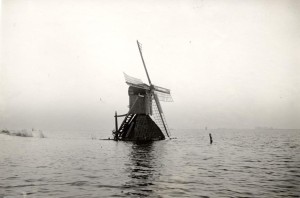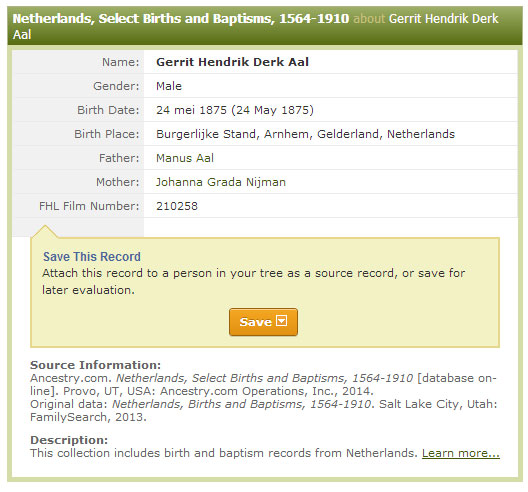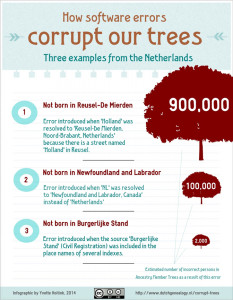 Through its partnership with Familysearch.org, Ancestry.com added millions of records from the Netherlands to their website this week. Just search the Card Catalog for databases with ‘Netherlands’ in the title. The new record sets include:
Through its partnership with Familysearch.org, Ancestry.com added millions of records from the Netherlands to their website this week. Just search the Card Catalog for databases with ‘Netherlands’ in the title. The new record sets include:
- Netherlands, Select Births and Baptisms, 1564-1910 (in Dutch) [6.2 million records]
- Netherlands, Select Marriages, 1565-1892 (in Dutch) [1.4 million records]
- Netherlands, Select Deaths and Burials, 1668-1945 (in Dutch) [0.6 million records]
Great news right? Well, maybe not so much. There are several problems with these record sets that severely limit their usefulness and will even cause major errors in family trees.
Problem 1: No information about provenance
The first problem is that the description of these record sets are very vague. The Ancestry.com description just says they were obtained from Familysearch. The description of the first data set is: ‘This collection includes birth and baptism records from Netherlands.’ It has a link to the description on the data set on the Familysearch Wiki, where it says:
It is not necessarily intended to index any specific set of records. This index is not complete for any particular place or region. This collection may include information previously published in the International Genealogical Index or Vital Records Index collections.
The individual index entries do not reveal where they come from, which means we cannot evaluate their reliability. An entry distilled from a family tree has a totally different reliability than an index entered by a group of volunteers working from the originals, trained by an archivist. Without knowing where these index entries came from, we have to regard them as unreliable.
Problem 2: No information about coverage
The description of the databases does not say which towns are included and which towns are not. This means we cannot draw any conclusions from negative results. We don’t know if we didn’t find the marriage record because a person wasn’t married at all, was married elsewhere or because the town wasn’t indexed.
Problem 3: Artificial combination of sources
The fact that church records (<1811) and civil registration records (>1811) have been dumped together in one database is a bad sign. These are two totally different administrations, with totally different degrees of reliability.
Problem 4: Missing places and dates
There are many records in the first set that just name a person with his or her spouse and child, without a date or place. If you look carefully, the name of the child is a link, which will take you to the detail page of the child, which will have its place and date of birth. But how many people will notice?
Problem 5: Missing churches and religions
The baptismal records do not include information about the church where the child was baptized, or even the religion. This makes it harder to trace the original record to verify the information from the index.
Problem 6: It’s just an index
The databases are just indexes, without scans of the original records. This would not be a problem if the index provided enough information to retrieve the original record, but since there is no source citation we don’t know where to look for it.
Problem 7: ‘Burgerlijke Stand’ is not a village!
The last problem may be the most damaging of all.
In several instances, I have seen ‘Burgerlijke Stand’ in the ‘birth place’ or ‘baptism place’ field. See the example below, where the person is said to have been born in ‘Burgerlijke Stand, Arnhem, Gelderland, Netherlands.’ However, Burgerlijke Stand is the Dutch term for Civil Registration. Saying someone was born in Burgerlijke Stand, Arnhem is like saying that someone was born at the Register of Deeds, New York. It does not make sense.

Example with ‘Burgerlijke Stand, Arnhem’ as place of birth
To me, this last problem is the most severe and has the potential to wreak havock among trees. I see a whole range of new erroneous birthplaces come up, just like with Reusel-De Mierden. People will attach these records to their trees, which will make this erroneous birth place show up in trees and be multiplied from there. How many new brick walls will be introduced when people cannot find the birth place ‘Burgerlijke Stand’?
Conclusion
While I applaud Ancestry.com and Familysearch’s efforts to make as many records as possible available to us, I do not think this is the way to do it and caution anyone who intends to use these records to be very careful and double-check all the findings.

UPDATE:
There we go: 2,338 people with “burgerlijke stand ” as place of birth in public member trees already.
UPDATE 2:
I created an infographic of these and other errors.


Arrgghh!! And there are so many wonderful collections of actual scans on FamilySearch to use in conjunction with WieWasWie and other online indexes other than Ancestry….Sadly, too many people will stop at Ancestry.
Such a missed chance! Hope they will correct this as soon as possible! They just gave Burgerlijke Stand the wrong code in the index and now it’s all scrambled up!
It is amazing how fast something like that can spread. I hope Ancestry put a warning on it.
Sounds like a case of awful quality control Yvette. Your anticipated affect of family trees has been shown to be spot-on. I don’t believe those corrupted place names will ever be changed, and they will just get copied and re-copied like so much other family-tree data.
Note that the FHL microfilm number is there, which can be looked up in the FHLibrary Catalog.
There are likely to be many microfilm numbers in any given database group.
The introductory material for each states that the microfilm number is with each index entry (these are not **records**).
Unfortunately my spot-check found quite a few entries for which there was no microfilm number. These could be from the old IGI, but who can tell?
Thanks for that follow-up. Most of the examples I checked had no FHL microfilm number, but that is very useful if it is there.
Just to clarify, all 2338 family tree entries of “Burgerlijke Stand” are not a result of these data sets being added to ancestry.com. Clicking through several tree entries, I found no links to any new Dutch databases, with most of the trees not having been updated in months or years. It’s still a problem, but it didn’t spread to over 2000 people within a week. (Although maybe it could with momentum.)
I agree with you, these errors probably originated when people used this same record set on Familysearch.org and then added that information to their Ancestry Member Tree. But I bet these errors will multiply quickly now that you can simply attach them to a tree 🙁
Tamura Jones has picked up your blog post and shown that the “Burgelijke Stand” error isn’t Ancestry.com’s fault, but FamilySearch’s fault.
https://plus.google.com/u/0/+TamuraJones/posts/87RznXBTDPm
Expect a lot of traffic to your blog! 🙂
Wonderful! Thanks for the heads-up!
Had sooooooo many “Newfoundland and Labrador” records—calling them out on that made me laugh out loud!
I am so grateful for all the records. The Dutch records are so specific and the information makes doing genealogy for my families in the Netherlands. I started using WeiWasWei and the archives there but because I don’t speak Dutch (my great-grandma Vos-Witteveen did) I had to look up almost every word. My family has been searching since the early ’30s for our Dutch family. Early on there was some success but someone needed to speak Dutch and know someone in the Netherlands to get records or information was passed along through family remembrances. As time has passed and with the advent of computers, that has all changed for my family’s desire to connect with their ancestors. I can now even email family I have never met but can link with on My Heritage website. It’s been so exciting and rewarding!
I very much appreciate your expertise in explaining the problems of the interface that is being used at present by Ancestry and FamilySearch. I now can better put in my basic information now that I have a better understanding of some of the (junk) that might be in a record or what might not ( just ran into the Burgerlijke Stand issue) – that’s how I found your website.
I am confident that though there are issues that need to be fixed in the program for these records at FamilySearch and Ancestry, they are really good at upgrading especially FamilySearch. In fact I will take this issue to my neighbor who is one of the programmers for FamilySearch. I bet you anything they are already working on it.